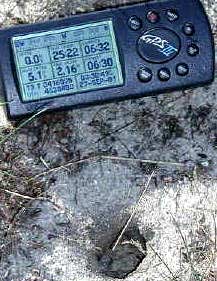Autumn Patrols — 27 September 2001
  Hatchling patrols continue into early autumn as Rags and I hopscotch along the Wellfleet coastline, checking and rechecking known nesting sites while sampling new areas that seem — at least from researcher and dog perspectives — potentially suitable habitat. Mostly we’re disappointed, but on occasion we hit pay dirt. And, as the pace of hatching slackens, we gain more and more time to devote to pure exploration. Hatchling patrols continue into early autumn as Rags and I hopscotch along the Wellfleet coastline, checking and rechecking known nesting sites while sampling new areas that seem — at least from researcher and dog perspectives — potentially suitable habitat. Mostly we’re disappointed, but on occasion we hit pay dirt. And, as the pace of hatching slackens, we gain more and more time to devote to pure exploration.
This morning began, as usual, with a release of hatchlings who had finished their stay at  Connemara Cottage, rested, warmed and were ready for adventures in the Land of Ooze. Hatchling 403 returned to her nesting site on Indian Neck and sprinted across the salt hay mat along the wrack line, disappearing into the tall, green marsh grass off Field Point. Connemara Cottage, rested, warmed and were ready for adventures in the Land of Ooze. Hatchling 403 returned to her nesting site on Indian Neck and sprinted across the salt hay mat along the wrack line, disappearing into the tall, green marsh grass off Field Point.
Immediately after releasing 403 and her siblings, we acquired another group of boarders from Nest 104 laid by Terrapin 268 on 28 June. With a north-northeast exposure, this nest has been slow to incubate with a couple of hatchlings popping out every few days. Today’s turtles bring the total to 10 emerged hatchlings with 3 remaining in the egg chamber.
 
Last evening I received a call from an Old Wharf resident. He had noticed “a lot of activity” along his beachline. Would I care to investigate?
We found 10 nests bunched within a 50-foot strip of low dune, mostly covered with beach grass and bearberry. A large canine predator (probably coyote) had exposed each of these nests, but arrived too late to do any substantial damage. One nest had still held four pipped hatchlings, who unfortunately were chewed and discarded. Based on my experience from this last springtime when coyotes had excavated overwintered nests, it seems that once an egg chamber is breached by hatchlings, the smell becomes too compelling for these predators to ignore. Yet they don’t seem interested in consuming the contents once they’ve exposed the nest. In all, more than 102 live hatchlings had emerged from this small site, which now jumps high on the priority list of objectives for next year’s research program.
  In the afternoon, Rags and I stumbled across a new nesting area on a dirt road high above Turtle Point. We located two emergence holes along the north shoulder of the road within 20 feet of each other. With precise locations measured, we should be prepared to give this spot appropriate attention during next June’s nesting season. In the afternoon, Rags and I stumbled across a new nesting area on a dirt road high above Turtle Point. We located two emergence holes along the north shoulder of the road within 20 feet of each other. With precise locations measured, we should be prepared to give this spot appropriate attention during next June’s nesting season.
The final surprise of the day came as a storm front closed in from the west. Last season a new seawall and sandbag barrier, as well as dense sand fencing, had blocked access to a significant slice of the north beach of Lieutenant Island where terrapins have historically nested. Few turtles and no nests have been detected in this area since the barrier’s construction.
This evening we scaled the high dune to the left of the picture and discovered a nest at its peak. It contained the shell remnants of 18 emerged hatchlings as well as one viable egg. In order to reach this spot, the terrapin would have had to encircle the barricade and approach the dune from the back and east (left). Quite an adventurous feat! Sadly, Nest 304 proved the only one I could find in this once highly productive area. We clearly need to find more effective ways to ensure access to such fertile upland nesting sites while still protecting home sites from tidal erosion.

|